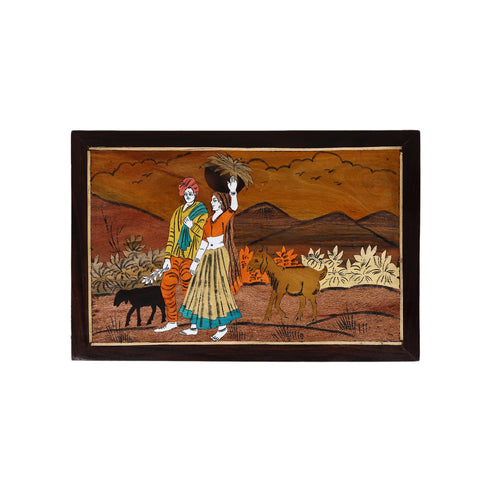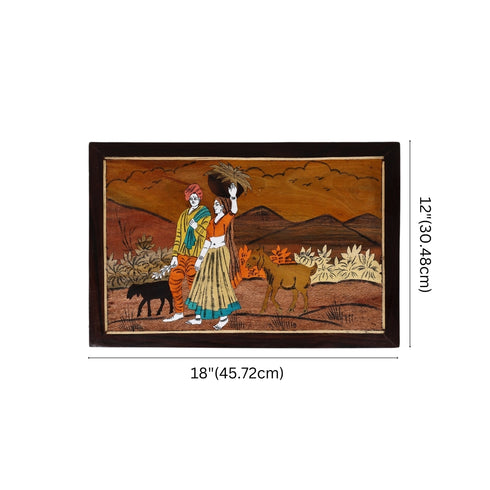Out of Stock
Wooden Mysore Inlay Painting of Rural Couple with Goats
₹1,799
₹1,259
Save 31%
This GI-Tagged Mysore Rosewood Inlay Art beautifully portrays rural life, showing a woman carrying a basket on her head, walking alongside her spouse towards the farm. Crafted without paint, each detail is made using colourful woods and acrylic sheets, capturing the serenity of village life and the strength of women.
Buying for a group or event?
Make a bulk enquiry

 Product Details
Product Details
- SKU Code: PT_WD_00650_BR
- Art Type : Mysore Inlay
- Product : Painting
- Material : Wood
- Raw Material used : Fusion of rosewood, yellowwood, ebony, Pathangadamara, and colourful acrylic sheets
- Dimensions : Length-45cms, Width-1cms, Height-30cms
- Design : Rural Life
- Color : Brown
- Default Title Weight: 1.2 kg
- Category : Decor
- Sub-category : Wall Decor
- Packaging Content : Mysore Inlay Rosewood Painting of Love Birds X 1
- Country of Origin : India
 Features
Features
- The painting is GI-Tagged.
- Handcrafted by skilled artisans of Mysore with precision.
- Made from rosewood, colourful woods, and acrylic sheets—no paint-colours used.
- The painting depicts a rural couple walking towards the farm with their goats.
- A meaningful and elegant gift for lovers of Indian craftsmanship.
- Showcases the rich cultural heritage and artistry of India.
 Preserving Cultural Traditions
Preserving Cultural Traditions
Wooden inlay, an ancient art of adorning wooden surfaces by embedding materials like plastic, or various colored woods, has a rich history and has evolved over time. While ivory was traditionally used, modern ethical practices have shifted to plastic. Originating in Persia in the 18th century, wooden inlay made its way to India through Srirangapatna, Karnataka. Under the reign of Tipu Sultan and the Wodeyar dynasty, the craft saw immense growth. Skilled artisans, employed by the Maharaja of Mysore, embellished the Mysore Palace, with the rosewood doors of Amba Vilas Hall as evidence to their expertise. Today, Mysore remains a vibrant hub for this exquisite art form, blending traditional techniques with contemporary aesthetics. Celebrated for its intricate craftsmanship and historical significance, Mysore's wooden inlay art continues to captivate and inspire with its unique blend of heritage and modernity.
 Manufacturing Process
Manufacturing Process
The Intricate Craft of Mysore Wood Inlay: A Detailed Process
Creating a Mysore wood inlay masterpiece is a meticulous and labor-intensive process, demanding days of undivided attention and exceptional skill from artisans. Each step is crucial in bringing these intricate works of art to life. Let’s explore the detailed process behind this exquisite craft.
- Selecting the Base and Design: The journey begins with choosing the perfect wood for the base. Options like Sheesham, Teak, and Mysore Rosewood are carefully considered and cut into various shapes such as square, rectangular, circular, or oval planks. These planks are then smoothed and evened out by buffing the edges and surface to create a flawless foundation.
- Transferring the Design: Next, the desired design is either hand-drawn directly onto the wood surface or first sketched on paper before being transferred. Carbon paper or regular printer paper can be used for this purpose, and stencils may also aid in tracing the intricate patterns for inlay.
- Tracing and Hollowing the Design: With a marking knife, the artist meticulously traces the outline of the design onto the wood. The area within the outline is then hollowed out to a depth of 2-3 mm using chisels, creating grooves ready to receive the inlay materials.
- Laying the Inlay Material: The prepared grooves are filled with the chosen inlay materials, which may include bone, plastic, or colored woods. Glue is applied to secure the inlays, and a hammer is used to ensure they fit snugly and won’t shift out of place.
- Filling and Smoothing: Any gaps between the grooves and the inlay are filled with a mixture of glue, rosewood, and sawdust. Excess inlay material is removed using sandpaper, resulting in a smooth and even surface.
- Polishing and Finishing: Finally, the polished surface is achieved by applying beeswax, followed by a lacquer coating. This final touch gives the product a clean, lustrous appearance, enhancing its beauty and ensuring durability. Mysore’s wood inlay art is admired for its intricate craftsmanship and historical significance, making each piece a cherished part of India’s rich cultural heritage. This elaborate process reflects the dedication and expertise of artisans who continue to uphold this timeless tradition, blending heritage with contemporary innovation.
 Note
Note
- Use soft damp cloth for cleaning
- Each product may feature slight variations in color or craftsmanship, which adds to its uniqueness and should not be viewed as defects.
- Images may differ from the actual product in form and color due to variations in screen resolutions and device settings.













